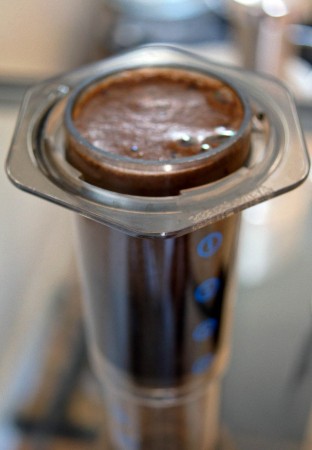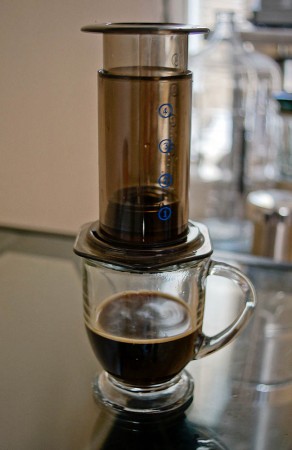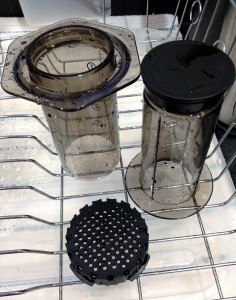 Not only does the AeroPress manage to look both futuristic and friendly at the same time, it makes the best (and easiest) cup of coffee I have ever had. And that’s saying a lot.
Not only does the AeroPress manage to look both futuristic and friendly at the same time, it makes the best (and easiest) cup of coffee I have ever had. And that’s saying a lot.
I started drinking coffee early on. Growing up in New York City, it was unavoidable. Starting around 9th grade, I would cop Anthora paper cups at the deli around the corner from my Upper West Side apartment. In 10th grade I officially became a regular at the diner down the street from my high school, where I’m sure the waitress loved when we piled in to a booth, six at a time, and ordered only cups of steaming, burnt swill, accompanied perhaps by a side of grilled corn muffin.
It wasn’t until sophomore year in college, when I met my future husband, that I actually tasted really great coffee. My caffeine addiction – by this point I couldn’t make it coffee-less past noon without a splitting headache – led me to spend an large amount of time in the many cafes of Providence, RI. While Starbucks had already begun its march to nationwide dominance, the green mermaid had yet to reach this New England town.
Independent coffee houses were everywhere, and my man was the manager of several, even learning to roast for Ocean Coffee Roasters, who provided many establishments with locally cooked-off beans (back in the early ’90s, before local was cool). In our loft we had a vacuum pot – or several, as the delicate multi-piece glass contraption had a knack for getting smashed to bits – and we reveled in brewing interesting blends of African, South American and Indonesian strains. Thanks to the cafe connections, we even had access to prized Hawaiian Kona and Jamaican Blue Mountain beans, now and then.
 Over the past two decades, our coffee routine has varied. There was a time, stuck living in the suburbs of South Jersey, that we saw fit to brew each morning using an industrial Bunn automatic drip brewer. There was an espresso phase, brought on by his spontaneous purchase of a $1000 all-in-one machine, a compact Italian-made device, the open-box floor model on sale for half-price at the Starbucks the next town over. Several methods were explored for home-roasting our Sweet Maria’s-ordered green beans, too: tiring our arms by hand-shaking a hot-air popcorn popper, getting frustrated over the inconsistency of a micro-batch air roaster. We settled on the dog-bowl method, using a heat gun, which we still use to this day.
Over the past two decades, our coffee routine has varied. There was a time, stuck living in the suburbs of South Jersey, that we saw fit to brew each morning using an industrial Bunn automatic drip brewer. There was an espresso phase, brought on by his spontaneous purchase of a $1000 all-in-one machine, a compact Italian-made device, the open-box floor model on sale for half-price at the Starbucks the next town over. Several methods were explored for home-roasting our Sweet Maria’s-ordered green beans, too: tiring our arms by hand-shaking a hot-air popcorn popper, getting frustrated over the inconsistency of a micro-batch air roaster. We settled on the dog-bowl method, using a heat gun, which we still use to this day.
By the time we moved back to the city, Chemex carafes were all the rage, and after I had the chance to pick one up for free (a friend got married and served the whole party Chemex-brewed goodness along with the wedding cake, so she had extras), we turned to that for our daily cup. Along the way we tried simple porcelain hand-pour cup-toppers, and even the Clever Coffee Dripper, the first time a plastic brewing device impressed me.
Last year, my husband happened upon an AeroPress while shopping in Philadelphia’s Italian Market, and brought one home so we could chuckle together about this odd-looking brewing device from the makers of the better-than-a-Frisbee Aerobie. With some trepidation, we tried it out, growing ever more excited as our tweaks to the ratios of grounds and water and timing produced ever tastier sips.
When I made a cup after self-proclaimed coffee nerd Mat Honan tipped me off to the inverted brewing method, used by many competitors at the World Aeropress Championships (oh, yes they did!), I knew I had found coffee nirvana.
@phillydesign I love mine too, it’s fantastic. Tried making it upside down? timwendelboe.no/2009/06/top-3-…
— apocryphal mat honan (@mat) December 16, 2011
Why does this hand-sized apparatus work as well as it does, and where did it come from? Palo Alto-based inventor/engineer Alan Alder holds over 40 patents, including one for the Aerobie flying disc, and he set out to create the perfect way to make coffee. After much experimentation, he came up with the final design, which has three distinct parts, made of three types of plastic: copolyester, polypropylene and a rubber-like thermoplastic elastomer (all of which are entirely food-safe).
The AeroPress achieves a great quaff thanks to achieving several of the “holy grails” of great coffee making. Here are brief descriptions of a few:
- Full immersion – ideally, all of the coffee meets all of the water for a short, set time. This is also the idea behind a vacuum pot. In drip brewers, water courses unevenly through the grounds, extracting not enough flavor at the start and over-extracting at the end, with more hitting the center of the filter basket than the edges. Pour-over methods attempt to fix this by allowing you to hand-distribute the water around the grounds.
- Proper temperature – boiling water is not optimum for extracting flavor from coffee. Water that’s too hot will scorch the grounds and pull too much acidity from them. This can happen easily in a vacuum pot, where the water is required to come to a boil just before meeting the coffee. Because you pour the water directly on to the grounds in an AeroPress, you can allow it to cool to the desired temps first, and because the process is so quick (see below), it will not cool too much before extraction is complete.
- Fast, even extraction – once the water and coffee come in to contact and have been allowed to mingle to create the desired strength brew, extraction should be as even and quick as possible. Commercial espresso machines rely on a (hard-to-get) very fine grind to allow water to move through the grounds with great speed. In the AeroPress, any size grind will work, and the precision with which the parts fit together creates air pressure, which is harnessed for a non-varying 20-second plunge.
 Good filtration – unless you’re a fan of the gritty dregs at the bottom of Greek or Turkish coffee, any particulate matter should be filtered from the final sip. The AeroPress takes a small paper filter, inserted above the screw-on filter cap, and when the disc is pre-rinsed with hot water, no paper taste attaches itself to the brew and zero grounds make their way into the cup. This is in total contrast with a French press, which produces “dirty,” or grounds-filled coffee.
Good filtration – unless you’re a fan of the gritty dregs at the bottom of Greek or Turkish coffee, any particulate matter should be filtered from the final sip. The AeroPress takes a small paper filter, inserted above the screw-on filter cap, and when the disc is pre-rinsed with hot water, no paper taste attaches itself to the brew and zero grounds make their way into the cup. This is in total contrast with a French press, which produces “dirty,” or grounds-filled coffee.- Ease of cleaning – coffee was once considered a luxury, but in our times, it’s a necessity (for most of us, anyway). The ability to easily deliver that morning cup as we rush around on our way to work or school is the reason automatic brew machines are so popular. Unfortunately, even those drip-monsters are much tougher to clean than the AeroPress. A few rinses in hot water and the parts are ready to go again. (Another direct contrast with the finicky French press, or with the fragile and convoluted vacuum pot.)
The other fantastic thing about this coffee-head/design-o-phile’s dream? Despite all parts being manufactured in California, it’s extremely affordable, ringing in at less than $30 on Amazon.
What are you waiting for? Go forth and press!